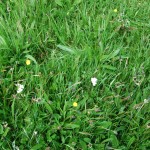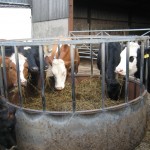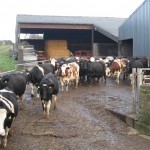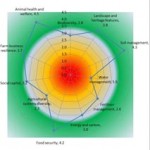


Sustainability assessment for this UK case farm
Crossbreeding approach and
local engagement
This small Welsh farm fitted very closely to the average scores for the UK farms as a whole, without high or low scores in any particular spur. The farm lies at 100 – 150 m above sea level. It became fully organic in 2003. It covers 46 ha which is largely grassland and has a herd of 72 milking cows and followers. A crossbreeding approach, using a variety of dairy bulls, has led to a medium sized, dual purpose cow, which is easy to manage, shows hybrid vigour and produces strong beef calves which are much sought after. Attention to detail in the milking routine and in maintaining general herd health has led to very low incidences of mastitis and lameness within the herd. Artificial insemination by farm staff immediately after milking reduces the time the cows are separated from the rest of the herd, thereby reducing stress and improving conception rates. A deliberate approach is to feed big bale silage which provides more long fibre and less acid loading, considered to be important for good rumen function and foot health. No cereals are grown on the farm so the level of purchased concentrates is quite high. 10% of the farm is reseeded every year, by planting forage rape in early summer which is grazed by the cows over winter. The following spring, the land is ploughed again and sown with barley and peas, undersown with a grass/clover ley. The fast growing arable crop suppresses weed growth and is cut for silage at 12 weeks, by which time the grass/clover ley is well established. Selling the milk through a local organic cooperative, which bottles it locally and sells it within Wales, reduces food miles and keeps employment and money within Wales.
Farm type:
Organic Dairy cows, Wales
 Livestock:
Livestock:
Dairy cows: 72
Milk production:(litres per cow per year): 6467
 Land data:
Land data:
Size: 46,4 ha.
Soil type: Medium
GLU -Grazing livestock units pr ha: 2.1 GLU/ha
 Forage and land use:
Forage and land use:
Pasture, high clover content: 42 ha.
Low input/rough grazing: 1 ha.
Other forage crops: 3,4 ha.
 Feeding:
Feeding:
How much of the feeding is roughage? 78 %
Local engagement:
Two farm walks in the past year
 Energy usage per year:
Energy usage per year:
Tractor diesel: 6061 litres
Electricity (farm usage only): 28,000 Kw hours
| N | P | K | ||
| Inputs kg/ha | 187 | 4.6 | 21.9 | |
| Outputs kg/ha | 61 | 11.0 | 15.6 | |
| Balance (kg/ha) | 126 | -6 | 6 |
| Efficiency of use (Ratio of outputs in products:inputs | 0.33:1 | 2.4:1 | 0.72:1 |
 Biodiversity and nature conservation:
Biodiversity and nature conservation:
5 % of area covered by Biodiversity Action Plan
All grassland under low input managment
1 ha species rich grassland under specific management
 Sustainability assessment for this UK case farm
Sustainability assessment for this UK case farm




